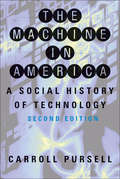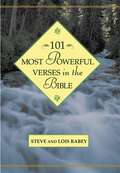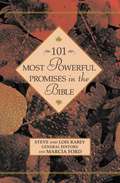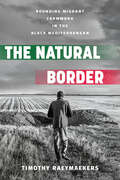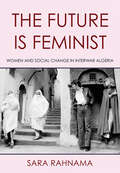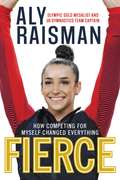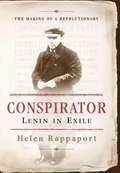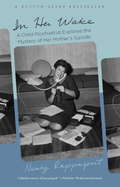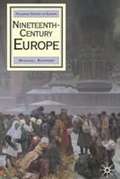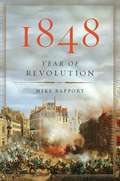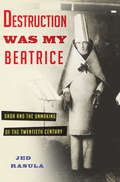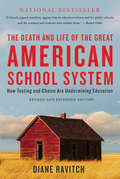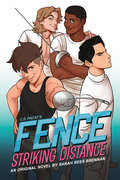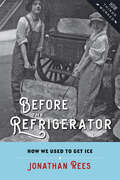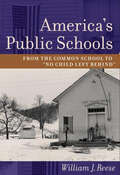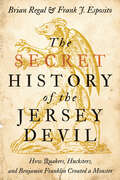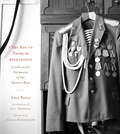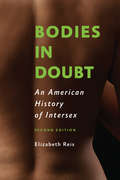- Table View
- List View
The Machine in America: A Social History of Technology
by Carroll PursellFrom the medieval farm implements used by the first colonists to the invisible links of the Internet, the history of technology in America is a history of society as well. Arguing that "the tools and processes we use are a part of our lives, not simply instruments of our purpose," historian Carroll Pursell analyzes technology's impact on the lives of women and men, on their work, politics, and social relationships—and how, in turn, people influence technological development.Pursell shows how both the idea of progress and the mechanical means to harness the forces of nature developed and changed as they were brought from the Old World to the New. He describes the ways in which American industrial and agricultural technology began to take on a distinctive shape as it adapted and extended the technical base of the industrial revolution. He discusses the innovation of an American system of manufactures and the mechanization of agriculture; new systems of mining, lumbering, and farming, which helped conquer and define the West; and the technologies that shaped the rise of cities. In the second edition of The Machine in America, Pursell brings this classic history up to date with a revised chapter on war technology and new discussions on information technology, globalization, and the environment.
101 Most Powerful Verses in the Bible
by Lois Rabey Steven RabeyThrough an examination of the Bible's most powerful verses, the newest installment in the 101 Most Powerful series reminds us that we are not alone in this world. In the Old Testament, God spoke through patriarchs, poets, and prophets. In the new Testament, he reaches out through Christ and Christ's disciples. Highlighting some of the key verses of the Bible, Steve and Lois Rabey demonstrate how God constantly communicates his will and his love to his children.
101 Most Powerful Promises in the Bible
by Steven Rabey Lois Rabey General Editors Marcia FordFor anyone who is searching for guidance in a time of need, finds that their faith is floundering, or simply wants to infuse some inspiration into their day, 101 MOST POWERFUL PROMISES IN THE BIBLE will provide the strength of God's message at the turn of a page.
The Natural Border: Bounding Migrant Farmwork in the Black Mediterranean
by Timothy RaeymaekersThe Natural Border tells the recent history of Mediterranean rural capitalism from the perspective of marginalized Black African farm workers. Timothy Raeymaekers shows how in the context of global supply chains and repressive border regimes, agrarian production and reproduction are based on fundamental racial hierarchies.Taking the example of the tomato—a typical 'Made in Italy' commodity—Raeymaekers asks how political boundaries are drawn around the land and the labor needed for its production, what technologies of exclusion and inclusion enable capitalist operations to take place in the Mediterranean agrarian frontier, and which practices structure the allocation, use and commodification of land and labor across the tomato chain. While the mobile infrastructures that mobilize, channel, commodify and segregate labor play a central role in the 'naturalization' of racial segregation, they are also terrains of contestation and power—and thus, as The Natural Border demonstrates, reflect the tense socio-ecological transformation the Mediterranean border space is going through today.
The Future Is Feminist: Women and Social Change in Interwar Algeria
by Sara RahnamaThe Future Is Feminist by Sara Rahnama offers a closer look at a pivotal moment in Algerian history when Algerians looked to feminism as a path out of the stifling realities of French colonial rule. Algerian people focused outward to developments in the Middle East, looking critically at their own society and with new eyes to Islamic tradition. In doing so, they reordered the world on their own terms—pushing back against French colonial claims about Islam's inherent misogyny. Rahnama describes how Algerians took inspiration from Middle Eastern developments in women's rights. Empowered by the Muslim reform movement sweeping the region, they read Islamic knowledge with new eyes, even calling Muhammad "the first Arab feminist." They compared the blossoming women's rights movements across the Middle East and this history of Islam's feminist potential to the stifled position of Algerian women, who suffered from limited access to education and respectable work. Local dynamics also shaped these discussions, including the recent entry of thousands of Algerian women into the workforce as domestic workers in European settler homes. While Algerian people disagreed about whether Algeria's future should be colonial or independent, they agreed that women's advancement would offer a path forward for Muslim society toward a more prosperous future. Through its use of Arabic-language sources alongside French ones, The Future Is Feminist moves beyond Algeria's colonial relationship to France to illuminate its relationship to the Middle East.
Fierce: How Competing for Myself Changed Everything
by Aly RaismanThe New York Times bestseller!Discover Aly Raisman's inspiring story of dedication, perseverance, and learning to think positive even in the toughest times on her path to gold medal success in two Olympic Games--and beyond. Aly Raisman first stepped onto a gymnastics mat as a toddler in a "mommy & me" gymnastics class. No one could have predicted then that sixteen years later, she'd be standing on an Olympic podium, having achieved her dreams. Aly's road to success was full of hard work, perseverance, and victories, but not without its hardships. Aly faced many obstacles, from naysayers who said she'd never make it in gymnastics to classmates who shamed her for her athletic body to a devastating betrayal of trust. Through it all, Aly surrounded herself with supportive family, friends, and teammates and found the inner strength to remain positive and believe in herself. Now, in her own words, Aly shows what it takes to be a champion on and off the floor, and takes readers on a behind-the-scenes journey before, during, and after her remarkable achievements in two Olympic Games--through her highest highs, lowest lows, and all the moments in between. Honest and heartfelt, frank and funny, Aly's story is enhanced with never-before-published photos, excerpts from the personal journals she's kept since childhood that chronicle memorable moments with her teammates, and hard-won advice for readers striving to rise above challenges, learn to love themselves, and make their own dreams come true.
That Girl, Darcy
by James RamosJames Ramos adds a quirky new spin to a beloved classic in his modern, gender-swapped retelling of Pride and Prejudice. Fans will feel they are meeting their favorite characters for the first time as they encounter new laughs, endless high school drama, and a timeless romance with a twist.
Conspirator: Lenin in Exile
by Helen RappaportThe father of Communist Russia, Vladimir Ilych Lenin now seems to have emerged fully formed in the turbulent wake ofWorldWar I and the Russian Revolution. But Lenin's character was in fact forged much earlier, over the course of years spent in exile, constantly on the move, and in disguise. In Conspirator, Russian historian Helen Rappaport narrates the compelling story of Lenin's life and political activities in the years leading up to the revolution. As he scuttled between the glittering capital cities of Europe-from London and Munich to Vienna and Prague-Lenin found support among fellow émigrés and revolutionaries in the underground movement. He came to lead a ring of conspirators, many of whom would give their lives in service to his schemes.A riveting account of Lenin's little-known early life, Conspirator tracks in gripping detail the formation of one of the great revolutionaries of the twentieth century.
In Her Wake: A Child Psychiatrist Explores the Mystery of Her Mother's Suicide
by Nancy RappaportIn 1963, Nancy Rappaport's mother committed suicide after a bitter divorce and custody battle. Nancy was four years old. As one of eleven children in a prominent Boston family, Nancy struggled to come to terms with the reasons why her mother took her own life. After years spent interviewing family and friends, Rappaport uncovers the story of a conflicted and troubled activist, socialite, and community leader. Drawing on court depositions, her mother's unpublished novel, newspapers, and her own experiences, she highlights heartbreaking stories of a complicated life that played out in the public eye. Inspiring, honest, and engaging, Rappaport's story sheds light on the agonizing nature of loss and healing, and reveals the permeable boundaries between therapists and the patients they treat.
Nineteenth Century Europe (PDF)
by Michael RapportThis new history of Europe spans from the French Revolution to the World War I. It weaves together the political, economic, social and cultural developments of the period and examines themes such as the relationship between state, civil society and the citizen; the emergency of mass politics (including women's emancipation movements); the impact of economic growth on society, politics and culture; and the development of identities (including gender, class and nation). While discussing events within the great powers, this useful text also ties smaller countries experiences into the narrative, for a comprehensive and thorough overview of Europe in the 19th century. Alternate ISBN 9780333652459
1848: Year of Revolution
by Mike RapportA "lively, panoramic" history of a revolutionary year (New York Times) In 1848, a violent storm of revolutions ripped through Europe. The torrent all but swept away the conservative order that had kept peace on the continent since Napoleon's defeat at Waterloo in 1815 -- but which in many countries had also suppressed dreams of national freedom. Political events so dramatic had not been seen in Europe since the French Revolution, and they would not be witnessed again until 1989, with the revolutions in Eastern and Central Europe. In 1848, historian Mike Rapport examines the roots of the ferment and then, with breathtaking pace, chronicles the explosive spread of violence across Europe. A vivid narrative of a complex chain of interconnected revolutions, 1848 tells the exhilarating story of Europe's violent "Spring of Nations" and traces its reverberations to the present day.
Destruction Was My Beatrice: Dada and the Unmaking of the Twentieth Century
by Jed RasulaIn 1916, as World War I raged around them, a group of bohemians gathered at a small nightclub in Zurich, Switzerland for a series of bizarre performances. Three readers simultaneously recited a poem in three languages; a monocle-wearing teenager performed a spell from New Zealand; another young man flung bits of papier-mâché into the air and glued them into place where they landed. One of these artists called the sessions "both buffoonery and a requiem mass.” Soon they would be known by a more evocative name: Dada.In Destruction Was My Beatrice, modernist scholar Jed Rasula presents the first narrative history of the emergence, decline, and legacy of Dada, showing how this strange artistic phenomenon spread across Europe and then the world in the wake of the Great War, fundamentally reshaping modern culture in ways we’re still struggling to understand today.
Destruction Was My Beatrice: Dada and the Unmaking of the Twentieth Century
by Jed RasulaIn 1916, as World War I raged around them, a group of bohemians gathered at a small nightclub in Zurich, Switzerland for a series of bizarre performances. Three readers simultaneously recited a poem in three languages; a monocle-wearing teenager performed a spell from New Zealand; another young man flung bits of papier-mâché into the air and glued them into place where they landed. One of these artists called the sessions "both buffoonery and a requiem mass.” Soon they would be known by a more evocative name: Dada.In Destruction Was My Beatrice, modernist scholar Jed Rasula presents the first narrative history of the emergence, decline, and legacy of Dada, showing how this strange artistic phenomenon spread across Europe and then the world in the wake of the Great War, fundamentally reshaping modern culture in ways we’re still struggling to understand today.
The Death and Life of the Great American School System: How Testing and Choice Are Undermining Education
by Diane RavitchAn urgent case for protecting public education, from one of America's best-known education expertsIn this landmark book, Diane Ravitch - former assistant secretary of education and a leader in the drive to create a national curriculum - examines her career in education reform and repudiates positions that she once staunchly advocated. Drawing on over forty years of research and experience, Ravitch critiques today's most popular ideas for restructuring schools, including privatization, the Common Core, standardized testing, the replacement of teachers by technology, charter schools, and vouchers. She shows conclusively why the business model is not an appropriate way to improve schools. Using examples from major cities like New York, Philadelphia, Chicago, Denver, and San Diego, Ravitch makes the case that public education today is in peril and includes clear prescriptions for improving America's schools.The Death and Life of the Great American School System is more than just an analysis of the state of play of the American education system. It is a must-read for any stakeholder in the future of American schooling.
Principles of Marketing 2.0
by Mary Anne Raymond Jeff TannerPrinciples of Marketing Version 2.0 by Tanner, Raymond and Schuster teaches the experience and process of actually doing marketing - not just the vocabulary. It carries five dominant themes throughout in order to expose students to marketing in today's environment: Service dominant logic - This textbook employs the term "offering" instead of the more traditional First "P" -- product. That is because consumers don't sacrifice value when alternating between a product and a service. They are evaluating the entire experience, whether they interact with a product, a service, or a combination. So the fundamental focus is providing value throughout the value chain, whether that value chain encompasses a product, service, or both. Sustainability; Increasingly, companies are interested in the impact they are having on their local community as well as the overall environment. This is often referred to as the triple bottom line of financial, social, and environment performance. Ethics and social responsibility; Following on the sustainability notion is the broader importance of ethics and social responsibility in creating successful organizations. The authors make consistent references to ethical situations throughout chapter coverage, and end of chapter material in most chapters will encompass ethical situations. Global coverage -- Tanner, Raymond and Schuster deliberately entitled Chapter 1; What is Marketing?; Whether it is today's price of gasoline, the current U.S. presidential race, or Midwestern U.S. farming, almost every industry and company needs strong global awareness. And today's marketing professionals must understand the world in which they and their companies operate. Metrics -- Firms today have the potential to gather more information than ever before about their current and potential customers. That information gathering can be costly, but it can also be very revealing. With the potential to capture so much more detail about micro transactions, firms should now be more able to answer ;well, what this marketing strategy really worth it?; And what is the marketing ROI?; And finally, what is this customer or set of customers worth to us over their lifetime? Principles of Marketing Version 2.0 brings new and updated coverage of new developments in the influence of social media to empower consumers, as well as marketing's use of social media, such as sentiment analysis, mobile marketing, and customer service and complaint tracking, as a communications and promotion channel, just a name a few. Version 2.0 also has an overall increased number of examples, as well as, new discussion questions in every chapter (resulting in at least 10 per chapter). In addition, the textbook's key terms, and repeated concepts have been strategically arranged to make customizing this book with Flat World's MIYO platform even easier.
Fence: Striking Distance
by Sarah Rees BrennanThe boys of Kings Row bout with drama, rivalry, and romance in this original YA novel by The New York Times bestselling author Sarah Rees Brennan -- inspired by the award-nominated comic series by C.S. Pacat and Johanna The Mad.Sixteen-year-old Nicholas Cox is the illegitimate son of a retired fencing champion who dreams of getting the proper training he could never afford. After earning a place on the elite Kings Row fencing team, Nicholas must prove himself to his rival, Seiji Katayma, and navigate the clashes, friendships, and relationships between his teammates on the road to state championships -- where Nicholas might finally have the chance to spar with his golden-boy half-brother.Coach Williams decides to take advantage of the boys' morale after a recent victory and assigns them a course of team building exercises to further deepen their bonds. It takes a shoplifting scandal, a couple of moonlit forest strolls, several hilariously bad dates, and a whole lot of introspection for the team to realize they are stronger together than they could ever be apart. The first installment of this enticing original YA novel series by Sarah Rees Brennan, rich with casual diversity and queer self-discovery, explores never-before-seen drama inspired by C.S. Pacat's critically acclaimed Fence comic series and boasts original cover and interior art by Johanna The Mad.Text and Illustration copyright: © 2020 BOOM! StudiosFence(TM) and © 2020 C.S. Pacat
Fence: Striking Distance
by Sarah Rees BrennanThe boys of Kings Row bout with drama, rivalry, and romance in this original YA novel by The New York Times bestselling author Sarah Rees Brennan — inspired by the award-nominated comic series by C.S. Pacat and Johanna The Mad. Sixteen-year-old Nicholas Cox is the illegitimate son of a retired fencing champion who dreams of getting the proper training he could never afford. After earning a place on the elite Kings Row fencing team, Nicholas must prove himself to his rival, Seiji Katayma, and navigate the clashes, friendships, and relationships between his teammates on the road to state championships -- where Nicholas might finally have the chance to spar with his golden-boy half-brother. Coach Williams decides to take advantage of the boys' morale after a recent victory and assigns them a course of team building exercises to further deepen their bonds. It takes a shoplifting scandal, a couple of moonlit forest strolls, several hilariously bad dates, and a whole lot of introspection for the team to realize they are stronger together than they could ever be apart. The first installment of this enticing original YA novel series by Sarah Rees Brennan, rich with casual diversity and queer self-discovery, explores never-before-seen drama inspired by C.S. Pacat's critically acclaimed Fence comic series and boasts original cover and interior art by Johanna The Mad. Text and Illustration copyright: © 2020 BOOM! StudiosFence(TM) and © 2020 C.S. Pacat
Before the Refrigerator: How We Used to Get Ice (How Things Worked)
by Jonathan ReesDuring the late nineteenth and early twentieth centuries, Americans depended upon ice to stay cool and to keep their perishable foods fresh. Jonathan Rees tells the fascinating story of how people got ice before mechanical refrigeration came to the household. Drawing on newspapers, trade journals, and household advice books, Before the Refrigerator explains how Americans built a complex system to harvest, store, and transport ice to everyone who wanted it, even the very poor.Rees traces the evolution of the natural ice industry from its mechanization in the 1880s through its gradual collapse, which started after World War I. Meatpackers began experimenting with ice refrigeration to ship their products as early as the 1860s. Starting around 1890, large, bulky ice machines the size of small houses appeared on the scene, becoming an important source for the American ice supply. As ice machines shrunk, more people had access to better ice for a wide variety of purposes. By the early twentieth century, Rees writes, ice had become an essential tool for preserving perishable foods of all kinds, transforming what most people ate and drank every day. Reviewing all the inventions that made the ice industry possible and the way they worked together to prevent ice from melting, Rees demonstrates how technological systems can operate without a central controlling force. Before the Refrigerator is ideal for history of technology classes, food studies classes, or anyone interested in what daily life in the United States was like between 1880 and 1930.
Before the Refrigerator: How We Used to Get Ice (How Things Worked)
by Jonathan ReesDuring the late nineteenth and early twentieth centuries, Americans depended upon ice to stay cool and to keep their perishable foods fresh. Jonathan Rees tells the fascinating story of how people got ice before mechanical refrigeration came to the household. Drawing on newspapers, trade journals, and household advice books, Before the Refrigerator explains how Americans built a complex system to harvest, store, and transport ice to everyone who wanted it, even the very poor.Rees traces the evolution of the natural ice industry from its mechanization in the 1880s through its gradual collapse, which started after World War I. Meatpackers began experimenting with ice refrigeration to ship their products as early as the 1860s. Starting around 1890, large, bulky ice machines the size of small houses appeared on the scene, becoming an important source for the American ice supply. As ice machines shrunk, more people had access to better ice for a wide variety of purposes. By the early twentieth century, Rees writes, ice had become an essential tool for preserving perishable foods of all kinds, transforming what most people ate and drank every day. Reviewing all the inventions that made the ice industry possible and the way they worked together to prevent ice from melting, Rees demonstrates how technological systems can operate without a central controlling force. Before the Refrigerator is ideal for history of technology classes, food studies classes, or anyone interested in what daily life in the United States was like between 1880 and 1930.
America's Public Schools: From the Common School to "No Child Left Behind" (The American Moment)
by William J. ReeseIn this update to his landmark publication, William J. Reese offers a comprehensive examination of the trends, theories, and practices that have shaped America’s public schools over the last two centuries. Reese approaches this subject along two main lines of inquiry—education as a means for reforming society and ongoing reform within the schools themselves. He explores the roots of contemporary educational policies and places modern battles over curriculum, pedagogy, race relations, and academic standards in historical perspective.A thoroughly revised epilogue outlines the significant challenges to public school education within the last five years. Reese analyzes the shortcomings of "No Child Left Behind" and the continued disjuncture between actual school performance and the expectations of government officials. He discusses the intrusive role of corporations, economic models for enticing better teacher performance, the continued impact of conservatism, and the growth of home schooling and charter schools. Informed by a breadth of historical scholarship and based squarely on primary sources, this volume remains the standard text for future teachers and scholars of education.
The Secret History of the Jersey Devil: How Quakers, Hucksters, and Benjamin Franklin Created a Monster
by Brian Regal Frank J. EspositoLegend has it that in 1735 a witch named Mother Leeds gave birth to a horrifying monster;¢;‚¬;€?a deformed flying horse with glowing red eyes;¢;‚¬;€?that flew up the chimney of her New Jersey home and disappeared into the Pine Barrens. Ever since, this nightmarish beast has haunted those woods, presaging catastrophe and frightening innocent passersby;¢;‚¬;€?or so the story goes. In The Secret History of the Jersey Devil, Brian Regal and Frank J. Esposito examine the genesis of this popular myth, which is one of the oldest monster legends in the United States.According to Regal and Esposito, everything you think you know about the Jersey Devil is wrong. The real story of the Jersey Devil's birth is far more interesting, complex, and important than most people;¢;‚¬;€?believers and skeptics alike;¢;‚¬;€?realize. Leaving the Pine Barrens, Regal and Esposito turn instead to the varied political and cultural roots of the Devil's creation. Fascinating and lively, this book finds the origins of New Jersey's favorite monster not in witchcraft or an unnatural liaison between woman and devil but in the bare-knuckled political fights and religious upheavals of colonial America. A product of innuendo and rumor, as well as scandal and media hype, the Jersey Devil enjoys a rich history involving land grabs, astrological predictions, mermaids and dinosaur bones, sideshows, Napoleon Bonaparte's brother, a cross-dressing royal governor, and Founding Father Benjamin Franklin.
The Secret History of the Jersey Devil: How Quakers, Hucksters, and Benjamin Franklin Created a Monster
by Brian Regal Frank J. EspositoLegend has it that in 1735 a witch named Mother Leeds gave birth to a horrifying monster;¢;‚¬;€?a deformed flying horse with glowing red eyes;¢;‚¬;€?that flew up the chimney of her New Jersey home and disappeared into the Pine Barrens. Ever since, this nightmarish beast has haunted those woods, presaging catastrophe and frightening innocent passersby;¢;‚¬;€?or so the story goes. In The Secret History of the Jersey Devil, Brian Regal and Frank J. Esposito examine the genesis of this popular myth, which is one of the oldest monster legends in the United States.According to Regal and Esposito, everything you think you know about the Jersey Devil is wrong. The real story of the Jersey Devil's birth is far more interesting, complex, and important than most people;¢;‚¬;€?believers and skeptics alike;¢;‚¬;€?realize. Leaving the Pine Barrens, Regal and Esposito turn instead to the varied political and cultural roots of the Devil's creation. Fascinating and lively, this book finds the origins of New Jersey's favorite monster not in witchcraft or an unnatural liaison between woman and devil but in the bare-knuckled political fights and religious upheavals of colonial America. A product of innuendo and rumor, as well as scandal and media hype, the Jersey Devil enjoys a rich history involving land grabs, astrological predictions, mermaids and dinosaur bones, sideshows, Napoleon Bonaparte's brother, a cross-dressing royal governor, and Founding Father Benjamin Franklin.
I Try Not to Think of Afghanistan: Lithuanian Veterans of the Soviet War (NIU Series in Slavic, East European, and Eurasian Studies)
by Anna ReichI Try Not to Think of Afghanistan includes photographs and commentaries from Lithuanian veterans of the Soviet War in Afghanistan (1979–89), addressing the lasting realities of war and its effects on those conscripted to fight. Unflinching first-person accounts give details of training, combat, and the often difficult return to society for military conscripts within the Soviet system. Anna Reich gives insight into the experiences of not only the Lithuanian veterans from the Soviet War in Afghanistan but also veterans from all countries who face similar struggles and challenges.For three months, Reich interacted with twenty-two veterans in their homes and meeting halls and throughout their daily routines to produce portraits that provide intimate and unvarnished portrayals of their lives and the lasting effects of forced military service in the Soviet army. Often ostracized socially because of their involvement with the Soviet army, the veterans frequently feel invisible: there are no social programs to assist them in their attempts to address post-traumatic stress disorder and assimilate into society, their cause is largely unknown, and the government responsible for their conscriptions no longer exists.I Try Not to Think of Afghanistan is the culmination of eight years of investigation into the psychological toll of war and trauma. In providing a rarely seen perspective of life after combat, the book intersects with contemporary discourse, specifically the way the US experience in Afghanistan closely mirrors that of the Soviets and the Russian Federation's forced conscription of young men to fight in Ukraine.
Bodies in Doubt: An American History of Intersex
by Elizabeth ReisThis renowned history of intersex in America has been comprehensively updated to reflect recent shifts in attitudes, bioethics, and medical and legal practices.In Bodies in Doubt, Elizabeth Reis traces the changing definitions, perceptions, and medical management of intersex (atypical sex development) in America from the colonial period to the present. Arguing that medical practice must be understood within its broader cultural context, Reis demonstrates how deeply physicians have been influenced by social anxieties about marriage, heterosexuality, and same-sex desire throughout American history In this second edition, Reis adds two new chapters, a new preface, and a revised introduction to assess recent dramatic shifts in attitudes, bioethics, and medical and legal practices. Human rights organizations have declared early genital surgeries a form of torture and abuse, but doctors continue to offer surgical "repair," and parents continue to seek it for their children. While many are hearing the human rights call, controversies persist, and Reis explains why best practices in this field remain fiercely contested.
Bodies in Doubt: An American History of Intersex
by Elizabeth ReisThis renowned history of intersex in America has been comprehensively updated to reflect recent shifts in attitudes, bioethics, and medical and legal practices.In Bodies in Doubt, Elizabeth Reis traces the changing definitions, perceptions, and medical management of intersex (atypical sex development) in America from the colonial period to the present. Arguing that medical practice must be understood within its broader cultural context, Reis demonstrates how deeply physicians have been influenced by social anxieties about marriage, heterosexuality, and same-sex desire throughout American history In this second edition, Reis adds two new chapters, a new preface, and a revised introduction to assess recent dramatic shifts in attitudes, bioethics, and medical and legal practices. Human rights organizations have declared early genital surgeries a form of torture and abuse, but doctors continue to offer surgical "repair," and parents continue to seek it for their children. While many are hearing the human rights call, controversies persist, and Reis explains why best practices in this field remain fiercely contested.
